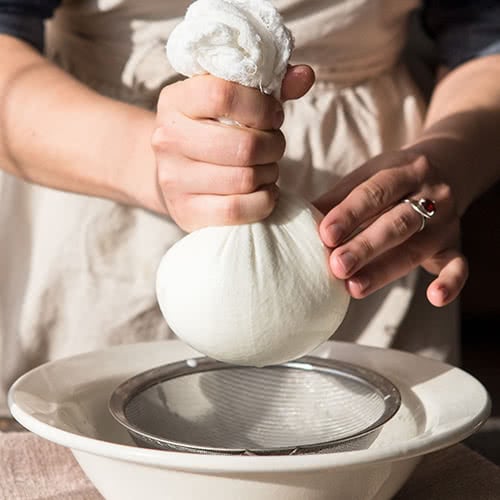What Is Cheesecloth?
Last updated on Nov 16, 2020Jason KurtzCheesecloth is a lightweight, cotton gauze fabric with an open texture, and it is primarily used for food preparation. As its name suggests, cheesecloth was originally used to drain and wrap curds during the cheese-making process. Over time, it has grown to be used for a variety of food preparation tasks and has become one of the most useful tools you can keep in your kitchen!
What Is Cheesecloth Made Of?

Cheesecloth is made from a woven cotton gauze fabric, giving it a light and airy texture. While it is always made from the same material, cheesecloth comes in a variety of durability ratings and thicknesses. Its thickness is measured by grade, which is determined by the number of threads per inch in each direction.
Cheesecloth grades are depicted in units of 10, with each unit signifying a sturdier and more durable cloth. A cheesecloth with a grade of 10 or 20 features a more open weave, allowing more material to pass through at the expense of durability. Likewise, a cheesecloth with a grade of 90 would be the most durable, but harder for liquids to pass through.
Cheesecloth Uses
Besides making different types of cheese, cheesecloth can be used for a variety of tasks. Its woven fabric design and breathable texture make it a versatile tool to keep on hand. Below, we’ve compiled a list of functions that cheesecloth can serve in your kitchen.
- Straining water
- Capturing solids in various recipes
- Bundling herbs and spices
- Dusting baked goods
- Thickening yogurt
- Making tofu and ghee
- Wrapping citrus fruits
Cheesecloth Substitute

If you don’t have access to cheesecloth or have chosen to search for an alternative, there are several materials you can use in its place. A good cheesecloth replacement should be lightweight and able to filter solids from liquid. If you're looking to find a suitable alternative for cheesecloth, consider the following materials:
- Muslin: Muslin is a lightweight cotton fabric that is commonly used in articles of clothing and culinary settings. It is lighter than cotton, but also less durable.
- Cotton Fabric: Cotton is one of the most commonly accessible pieces of fabric in the world. While it may not be woven quite like cheesecloth and isn't available in different grades, its light, breathable texture makes it a suitable replacement in the right situation.
- Coffee Filter: Coffee filters are one of the more common cheesecloth substitutes and can be found in most kitchens. The main difference between the two is that a coffee filter is made of paper, while cheesecloth is made of cotton. Because of this, coffee filters may be less durable than cheesecloth.
- Medical Gauze: Medical gauze is thinner and less sturdy than cheesecloth. Despite this, they are made from similar materials, making medical gauze a suitable substitute if you use multiple layers.
- Paper Towels: Similar to a coffee filter, paper towels are more prone to breakage than cheesecloth. However, if you plan on straining light foods or looking for a breathable material to cover your food with, paper towels will work perfectly.
- A Clean Sock: While using a sock in the kitchen may seem unusual, it’s possible to use one as an effective cheesecloth alternative. Most common socks are made from a blend of cotton, wool, nylon, or polyester. Their woven design makes them breathable, yet durable, allowing them to serve a similar function as a cheesecloth as you cook.
Can You Reuse Cheesecloth?
Depending on what you’ve used it for, it is possible to reuse cheesecloth. However, it’s essential to clean your cheesecloth if you plan on using it again. Using it to strain, cover, or wrap uncooked or perishable foods can cause your cheesecloth to accumulate bacteria, as well as stains. For food safety reasons, you must clean your cheesecloth thoroughly before reusing it in your kitchen.
How to Clean Cheesecloth

There are many different methods you can use to clean your cheesecloth. Using it in the kitchen can leave your cheesecloth with stains or leftover bacteria, so for food safety reasons, it's important to keep them clean. Consider using the following methods to effectively clean your cheesecloth:
Cleaning Cheesecloth by Hand
- Prepare hot water and rinse your cheesecloth in it immediately after use. If your cheesecloth has food stains, rinse it immediately for the best chance of getting rid of them.
- If your cheesecloth has leftover bits of food or stronger stains, soak it in a solution of baking soda and hot water. Let it stand for up to 30 minutes before removing it from the solution. Rinse your cloth thoroughly afterward.
- To make sure no germs or bacteria remain on your cheesecloth after use, boil it for up to 5 minutes. It’s best to boil your cheesecloth after every use to eliminate the risk of transmitting pathogens and bacteria.
Cleaning Cheesecloth in the Washing Machine
- Rinse your cheesecloth under hot water before running it through the washing machine.
- Use delicate detergent and wash your cloth along with other cloths to prevent damage inside the washing machine.
- If you’re using a cheesecloth alternative such as muslin, it can easily be washed in the washing machine.
How to Dry Cheesecloth
- Once you’ve washed your cheesecloth, consider drying it in either a dryer or in the sun.
- Fold and store your cheesecloth in a plastic bag.
Cheesecloth is a useful material that can be used to complete a variety of tasks in the kitchen. Additionally, its properties make it easy to replace or substitute for if you don't have access to it. The next time you're looking for a lightweight, breathable fabric to help complete a recipe, consider using cheesecloth.



